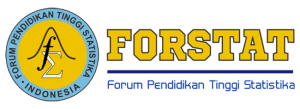Analisis Jumlah Penduduk Miskin di Provinsi Maluku dengan Menggunakan Pendekatan Regresi Spasial
DOI:
https://doi.org/10.34123/jurnalasks.v13i2.294Keywords:
Kemiskinan, Regresi Spasial, Spatial Lag ModelAbstract
Maluku Province is in the 4th poorest province in Indonesia with a poverty rate of 18.45% of the total population in Maluku. The spatial aspect needs to be studied because the characteristics of each area or region are different so that information about the characteristics of this location can be captured using a spatial regression model. The purpose of this study is to examine the characteristics of poverty in Maluku Province, then determine the factors that affect poverty in Maluku province using spatial regression, and get the best model to model poverty in Maluku Province. The results showed that the average percentage of poor people in Maluku province is 22.71%, where Southwest Maluku Regency has the highest percentage of 31.01% and Kota Ambon has the lowest percentage of 4.64%. While the significant factors affecting poverty in Maluku province by using spatial regression are the percentage of households (rt) whose cooking fuel from wood (X1), percentage of non-school-aged 7 - 24 years (X2) (X3), percentage of the unemployed (TP) (X4) and percentage of labor force participation rate (X5) and the best model obtained to model poverty in Maluku Province is Spatial Lag Model.
Downloads
References
Anselin, L. (1988). Spatial Econometrics : Methods and Models. Dordrecht: Kluwer Academic Publishers.
Anton Howard (1992). Dasar-dasar Aljabar Linier oleh Syarifudin, Mike Damayanti, Yayan Wulandari ; Tangerang; Binapura Aksara
Aulele, S. N. (2014). Pendekatan Model Geographically Weighted Regression untuk Menentukan Faktor-faktor yang Mempengaruhi Jumlah Rumah Tangga Miskin di Pulau Buru. BAREKENG: Jurnal Ilmu Matematika dan Terapan, 8(2), 53-57.
Badan Pusat Statistik dan Depsos/Departemen Sosial (2002), Penduduk Fakir Miskin Indonesia 2002, Jakarta: BPS
Bain, L. J., & Engelhard, M. (1992). Introduction to Probability and Mathematical Statistics. California: Duxburry Press.
BPS Provinsi Maluku. 2017. Profil Kemiskinan di Maluku tahun 2017. Badan Pusat Statistik Provinsi Maluku: Ambon.
Draper, N. R., & Smith, H. (1992). Analisis Regresi Terapan. Jakarta: PT. Gramedia Pustaka Utama.
Johnson, R.A. dan Wichern, D.W., 2007, Applied Multivariat Statistical Analysis, New Jersey, Pretice Hall.
Laswinia, V. D., & Chamid, M. S. (2016). Analisis Pola Hubungan Persentase Penduduk Miskin dengan Faktor Lingkungan, Ekonomi, dan soaial di Indonesia, Menggunakan Regresi Spasial. Jurnal Sains dan Seni ITS Vol 5 No 2.
Leleury, Z. A., & Tomasouw, B. P. (2019). Pengelompokkan dan Pemetaan Karakteristik Kemiskinan di Kabupaten Maluku Barat Daya Provinsi Maluku dengan menggunakan Self-Organizing Map dan Analisis Biplot. BAREKENG: Jurnal Ilmu Matematika dan Terapan, 13(2), 093-106















